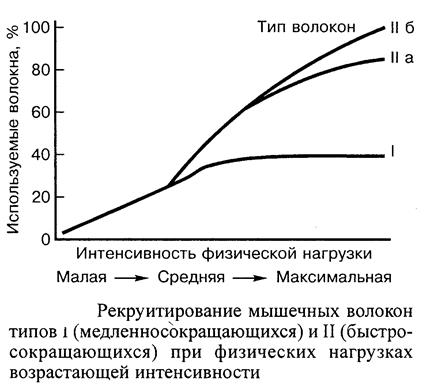The fact that there are several types of muscle fibers in a muscle needs to be told separately. A muscle never works as a single unit. Bodybuilders need to deeply realize this. The composition of the muscle includes fibers that are different in their “specialization”.
There are two main types of muscle fibers – fast contracting muscle fibers and slow contracting muscle fibers). Based on the significance for the body, Dr. Burke (E.R. Burke), a scientist from the USA, who studied this problem, proposed to distinguish muscle fibers by a combination of two features – the speed of contraction and resistance to fatigue. In the first classification proposed by Burke, muscle fibers were divided into three types:
– S (slow) – slow, highly resistant to fatigue;
– FR (fast, resistant) – fast, resistant to fatigue;
– FF (fast, fatigable) – fast, rapidly fatigable;
Further, in another paper, Burke introduced another type FI (fast, intermediate in fatigability) – fast intermediate into the group of fast muscle fibers.
Muscle fibers of type S contract slowly and have an oxidative (oxidative) type of metabolism.
Muscle fibers of type FR are fast and have an oxdative-glycolytic metabolism.
Muscle fibers of type FI are fast, having an approaching glycolytic type of metabolism, although some energy is derived from oxidative metabolism.
Muscle fibers of type FF are fast, possessing a glycolytic metabolism.
The fiber types have very blurred boundaries – rather the fibers represent some single set corresponding to a gradual transition from anaerobic glycolysis to aerobic metabolism.
It all seems a bit confusing, but this information is really important, so try to focus your attention on absorbing the information presented.
So, to reiterate again. All the above mentioned muscle fiber types are differentiated by two factors:
- speed of muscle contraction, that is, the speed at which these fibers are able to contract;
- resistance to fatigue, that is, the type of energy supply of muscle activity – anaerobic (without the use of oxygen) and aerobic (with the use of oxygen).
But this is not all the differences. Directly for bodybuilding is very important the following point – muscle fibers differ not only in the speed of contraction and type of energy supply, but also in the size of the cross-section, that is – diameter.
This means that muscle fibers are not only groups using different ratios of energy supply types to ensure contraction, but also some unified set corresponding to the transition from fibers with a smaller diameter to fibers with a larger diameter. In other words, not all muscle fibers have the same diameter and, more importantly, the same potential for diameter increase..
Ignorance of this fact is an inexcusable mistake for many individuals involved in bodybuilding.
You must clearly understand that when you use different weights (as a percentage of your maximal weight) in your training, you are engaging different muscle fibers that have different diameters and therefore have different value in increasing the cross-section of the skeletal muscle that includes the fibers being trained.
So which fibers have a larger diameter? Fast-twitch muscle fibers – FF (fast, glycolytic metabolism) and FI (fast, near-glycolytic metabolism) fibers – have a larger diameter and the potential to increase diameter.
In humans, fast and slow muscle fibers are usually found together in the same muscle. The ratio of fast to slow muscle fibers is regulated by genetics. A person is simply born with a certain ratio of these types of muscle fibers and no study has shown that this ratio can be changed by training.
Practically speaking, this means that people who have more fast muscle fibers in their muscles from birth have an advantage in increasing muscle mass. This is with respect to bodybuilding. And as for other sports – these people will have an advantage in speed and strength, that is, in all speed and strength sports where fast, powerful and short-term efforts are important.
It may also be noted that in the same person, the ratio of fast and slow fibers in different muscles may not be the same. Accordingly, different muscles or muscle groups in such a person will have different “ceiling” in increasing muscle cross-section. This fact once gave rise to the legend of so-called “difficult” muscles to develop. “Difficulty” of which development was often due to genetic factors – the presence of a smaller number of rapidly contracting muscle fibers in these muscles.
Further, before outlining the factors influencing the involvement of fibers of different types, it is necessary to find out what the mentioned glycolytic and oxidative types of metabolism are. This question will be discussed in detail in the next chapter.
- Next chapter: 4. Energy supply of muscle contraction
- Previous chapter: 2. The structure of skeletal muscles
- Beginning
The use of materials of the site in printed publications is possible only after obtaining written permission of the author of the site.






